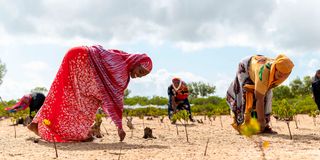Lamu ahead of the pack in funding of women's projects

Mtangawanda Women's Group members plant mangrove trees on the shores of Pate Island in Lamu. Lamu is the only county that invested in a flagship empowerment project targeting women in the first half of the 2023/24 financial year.
What you need to know:
- Last month, the Controller of Budget released a report reviewing how counties implemented the approved budgets in six months covering July 1 to December 31, 2023.
- Of all the counties, only Baringo had a youth and gender initiative listed among development projects with the highest expenditure in the reporting period.
Only one county invested in a flagship empowerment project targeting women in the first half of the 2023/24 financial year.
This revelation comes at a time when the world would take 300 years to achieve gender equality, according to the UN Women estimates.
Also read: Empower women for brighter future
Last month, the Controller of Budget released a report reviewing how counties implemented the approved budgets in six months covering July 1 to December 31, 2023.
Of all the counties, only Baringo had a youth and gender initiative listed among development projects with the highest expenditure in the reporting period.
It was constructing empowerment centres at a cost of Sh129.2 million. The project was ongoing and Sh19.1 million had been paid, which implies that at least 15 per cent of the work had been done.
Five counties had established empowerment funds for women, namely Lamu, Turkana, Makueni, Trans Nzoia and Bungoma. Kitui has an empowerment fund with no specified target group.
Save for Lamu's, the county kitties either had no approved budget, or had, but no shilling was made available as of December 31, 2023.
However, it’s difficult to trace development projects benefitting women in other departments as a harmonious framework capturing gender-related projects and milestones in the counties is non-existent.
In Makueni, the amount approved to the Tetheka Fund was a mere Sh500,000 and this money is not reserved for only women. It's a shared fund between the youth, women and persons living with disabilities. By December 31, 2023, not a single cent had been released to this fund, the report showed.
It was the same in Bungoma, which has a women's fund with an approved budget of Sh6 million but no cent in the kitty by closure of last year.
Also read: Why every woman should belong to a chama
In Turkana, the youth and women empowerment fund has an approved budget of Sh50 million, but by December 31, 2023, only Sh483,299 had been spent on them.
Trans Nzoia was a worst case scenario, as the youth and women development fund in place had no approved budget.
Also read: Chamas putting a big smile on women’s faces
Lamu was the only outstanding county. It had an approved budget of Sh10 million and by the end of last year, it had received and spent Sh8.3 million on women under its women empowerment fund.
From the Global Gender Gap Report produced by the World Economic Forum in 2022, women are lagging behind in every sector.
In economic participation and opportunity, 73 per cent of men were economically active, compared to 62.90 per cent of women.
Last year, the Kenya National Bureau of Statistics (KNBS) released data showing that men spent only 54 minutes in unpaid care work daily, including cooking, washing clothes and taking care of the children; unlike the women’s four-and-a-half hours.
Time is a crucial factor in participation of women in work that earns them an income. In exclusion of income, poverty levels hit the roof.
In the 2021 Kenya Poverty Report by the KNBS, women-headed households were found to have a higher poverty rate of 38.8 per cent, far higher than the national average of poor rural households approximated to be 38 per cent.
The poverty rate for the male-headed households was 32.7 per cent, though higher than the national average for the poor urban households set at 29.7 per cent.
In terms of political representation, WEF found Kenya had a mere 23.3 per cent inclusion of women in Parliament as the men took nearly a quadruple (76.70 per cent) of the seats.
In education, women constituted 9.73 per cent of the students who had enrolled for tertiary education compared to 13.20 per cent of men.
Pregnancy largely contributes to girls dropping out of school, which further reflects on the number of girls who proceed to post-secondary school education.
From the 2022 Kenya Demographic and Health Survey, while the percentage of adolescents who have begun childbearing shrunk from 18.1 per cent in 2014 to 14.9 per cent in 2022, the decline isn’t uniform.
Women’s rights organisations, which supplement governments’ work in uplifting women’s economic, social, political, cultural and technological status, are also facing a financial shortfall, with a decline in global donor funding.
Data from the Organisation for Economic Co-operation and Development show official development assistance to support women’s rights organisations and movements as well as government institutions dropped to $631 million on average per year in 2021/22, from $891 million in 2019/20.
In recent years, gender equality actors have launched spirited campaigns for innovative and sustainable funding for women’s empowerment programmes, including introducing gender bonds.





